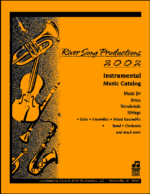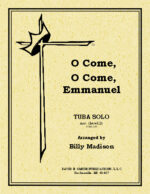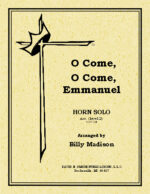-
Trouble The Water
$29.95“Wade in the Water” is a well-known spiritual that was one of the songs associated with the Underground Railroad. Since its first commercial recording in 1925 by the Sunset Four Jubilee Singers, it has been widely performed and recorded.
This arrangement stylistically emulates the theme of the popular 2017 television show The Chosen, which also uses this same spiritual. The title is taken from the last line of the song: “God’s gonna trouble the water.”
-
As Lately We Watched
$11.00A woodwind quartet with optional parts is presented in a joyful manner giving a sense of expectation. After a pert introduction, the melody is stated with a solo clarinet with answering figures rotated amongst the other voices. A joyful bridge section gravitates towards a modulation with the tune stated in the lower voices. The piece goes into a free, flourishing motion where it heads into yet another modulation. The tune now is doubled in the flute and clarinet with accompaniment figures moving in hemiola sets. After a set of imitation figures passed about the ensemble the piece goes into a coda section with more joyful figures.
-
Come To The Manger
$8.00An accompanied sax trio (A-A-A/T) opening with an exciting motive. The first rendition is in block harmonies with occasional rhythmic punctuations. The next section has subtle contrapuntal statements amongst all parts giving a joyous texture. After a modulation the ensemble alternates between solo statements and full ensemble giving contrasts in texture and color. Another modulation ensues where imitative motives take place through the voices only to come together in a solid fashion for an exciting ending.
-
Come To The Manger
$8.00An accompanied clarinet trio opening with an exciting motive. The first rendition is in block harmonies with occasional rhythmic punctuations. The next section has subtle contrapuntal statements amongst all parts giving a joyous texture. After a modulation the ensemble alternates between solo statements and full ensemble giving contrasts in texture and color. Another modulation ensues where imitative motives take place through the voices only to come together in a solid fashion for an exciting ending.
-
Come Thou Almighty King
$10.00An accompanied brass trio for trumpet, horn (trumpet) and trombone (baritone horn TC). The piece begins with a motive that is imitative and builds in intensity until the theme is presented in the trombone with punctuations from the upper voices. It continues much in this manner until the chorus erupts in block harmonies. After a modulation and meter change, the trio presents a fanfare style until it abruptly reverts to the original meter. And then a more solemn manner, all the while gaining strength until a conclusive ending.
-
-
-
Ding Dong Merrily On High
$12.00A cheerful arrangement for 2 trumpets, horn, trombone and piano. The piece moves the melody around to everyone for color and interest. Along with some bell effects, the theme is once again established and then a final chord.
-
O Come, O Come Emmanuel
$4.50A solo with piano accompaniment. After a solid introduction the arrangement presents the melody with a simple statement. After several melodic statements the soloist then presents itself with a delightful counterline. It is finalized with declamation.
-
O Come, O Come Emmanuel
$4.50A solo with piano accompaniment. After a solid introduction the arrangement presents the melody with a simple statement. After several melodic statements the soloist then presents itself with a delightful counterline. It is finalized with declamation.
-
O Come, O Come Emmanuel
$4.50A solo with piano accompaniment. After a solid introduction the arrangement presents the melody with a simple statement. After several melodic statements the soloist then presents itself with a delightful counterline. It is finalized with declamation.
-
O Come, O Come Emmanuel
$4.00A solo with piano accompaniment. After a solid introduction the arrangement presents the melody with a simple statement. After several melodic statements the soloist then presents itself with a delightful counterline. It is finalized with declamation.
-
O Come, O Come Emmanuel
$4.00A solo with piano accompaniment. After a solid introduction the arrangement presents the melody with a simple statement. After several melodic statements the soloist then presents itself with a delightful counterline. It is finalized with declamation.
-
O Come, O Come Emmanuel
$4.00A solo with piano accompaniment. After a solid introduction the arrangement presents the melody with a simple statement. After several melodic statements the soloist then presents itself with a delightful counterline. It is finalized with declamation.
-
O Come, O Come Emmanuel
$4.00A solo with piano accompaniment. After a solid introduction the arrangement presents the melody with a simple statement. After several melodic statements the soloist then presents itself with a delightful counterline. It is finalized with declamation.
-
O Come, O Come Emmanuel
$4.00A solo with piano accompaniment. After a solid introduction the arrangement presents the melody with a simple statement. After several melodic statements the soloist then presents itself with a delightful counterline. It is finalized with declamation.
-
O Come, O Come Emmanuel
$4.00A solo with piano accompaniment. After a solid introduction the arrangement presents the melody with a simple statement. After several melodic statements the soloist then presents itself with a delightful counterline. It is finalized with declamation.
-
O Come, O Come Emmanuel
$4.00A solo with piano accompaniment. After a solid introduction the arrangement presents the melody with a simple statement. After several melodic statements the soloist then presents itself with a delightful counterline. It is finalized with declamation.
-
O Come, O Come Emmanuel
$4.00A solo with piano accompaniment. After a solid introduction the arrangement presents the melody with a simple statement. After several melodic statements the soloist then presents itself with a delightful counterline. It is finalized with declamation.
-
O Come, O Come Emmanuel
$4.00A solo with piano accompaniment. After a solid introduction the arrangement presents the melody with a simple statement. After several melodic statements the soloist then presents itself with a delightful counterline. It is finalized with declamation.
-
O Come, O Come Emmanuel
$4.00A solo with piano accompaniment. After a solid introduction the arrangement presents the melody with a simple statement. After several melodic statements the soloist then presents itself with a delightful counterline. It is finalized with declamation.
-
O Come, O Come Emmanuel
$4.00A solo with piano accompaniment. After a solid introduction the arrangement presents the melody with a simple statement. After several melodic statements the soloist then presents itself with a delightful counterline. It is finalized with declamation.
-
-
The Twelve Days Of Brass
$13.00This Christmas favorite is scored for brass quintet (opt. Sextet) is full of delight right out of the gate. The twists and turns never end as it contorts through light-hearted variations and extensions. A real change of pace- this piece!
























